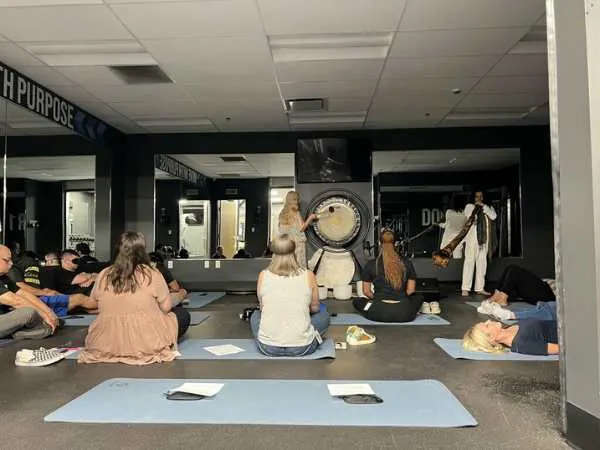Sound baths have moved from boutique studios into boardrooms, for good reason. In fast-paced workplaces, stress accrues silently and shows up as brain fog, irritability, and shallow breathing. A well-facilitated sound bath gives teams a rare chance to downshift together: lights low, phones away, guided breathing, and layered tones (think crystal bowls, chimes, gentle drones) that signal the nervous system to relax. The result isn’t just “nice vibes.” It’s a measurable reset employees can feel in the next meeting.
This guide explains what a corporate sound bath is, how it fits into a wellness day, how to run one in open offices (or hybrid), and how to measure impact so the event earns its slot on the calendar.
What a Corporate Sound Bath Is (and Isn’t)
A sound bath is a guided listening experience where participants sit or recline while a facilitator plays harmonically rich instruments and leads slow breathing. Unlike a concert, the goal isn’t entertainment; it’s nervous-system regulation, lower arousal, deeper breaths, steadier focus. Sessions can be silent-headphone (great for open floors), in-room (acoustic), or a hybrid.
Expected outcomes (reported by teams):
- Less muscle tension and “meeting hangover”
- Calmer mood, fewer interruptions while speaking
- Clearer focus for the next work block
Why It’s Trending at Work
- Fast impact in little time. Ten to thirty minutes delivers a real reset without derailing the day.
- Inclusive by design. No special clothes or fitness level required; seated or reclined options work.
- Hybrid-friendly. Headphones make it easy to include remote colleagues without audio bleed.
- Memorable. The shared quiet becomes a culture moment people talk about, in a good way.
Formats That Work for Wellness Days
Micro Reset (10–15 minutes)
- Two minutes of guided breathing
- Eight–ten minutes of layered tones
- One minute to “surface” and hydrate Use between workshops or before an important collaboration block.
Core Session (25–35 minutes)
- Centering breath + posture setup
- 18–25 minutes of evolving soundscape
- Gentle return + intention setting The sweet spot for lunch-and-learns or wellness day anchors.
Deep Session (45–60 minutes)
- Body scan + nervous-system education (2–3 minutes)
- 35–45 minutes of sound with dynamic swells and rests
- Journal prompt + pair share Great for offsites or quarterly wellness days.
A Sample Wellness-Day Run of Show (Half-Day)
- Arrival & Grounding (10 min) – Breath + two chair stretches
- Sound Bath (30 min) – Headphone or acoustic, lights dim
- Break (10 min) – Hydration + quiet reflection
- Co-Create Sprint (35 min) – Tackle one real workflow pain point
- Micro Sound Reset (8 min) – Short set to clear cognitive load
- Action Capture (15 min) – Owners, next steps, 30-day check-in
Logistics & Setup (Office, Offsite, or Hybrid)
Room & Layout
- Conference room, studio, or multipurpose space; aim for 10–20 sq ft per person if reclining
- Lights dim or eye masks; temperature slightly on the warm side
Sound Options
- Headphone sound bath: Silent-disco style, no building noise issues, precise volume control, perfect for open offices
- Acoustic set: Crystal bowls, chimes, ocean drum, soft synth; small PA only if needed
Hybrid Tips
- Send calendar hold + “what to bring” (water, sweater, optional mat)
- Encourage remote attendees to recline and use over-ear headphones
- Stream facilitator voice separately from the music if needed
Accessibility
- Offer chair-only version; share the flow in advance; provide a quiet exit path
Safety & Care Notes (Brief)
Most people can participate comfortably. Encourage anyone with photosensitive epilepsy, acute migraine, recent concussion, or sound sensitivity, plus those who are pregnant or have cardiac devices, to consult their clinician and/or choose a lighter, chair-based version. Keep volumes modest and give participants control (earplugs on request, volume guidance for headphones). Include a short re-orientation (“wiggle fingers, open eyes slowly”) before returning to work.
This is educational content, not medical advice.
How to Measure Impact (So It’s Not Just “Nice”)
Pulse survey (1–5) before and after:
- Stress, focus, and “I feel connected to my team”
Behavioral signals (next 2–4 weeks):
- Shorter meeting ramp-up time
- Fewer Slack escalations during peak hours
- Adoption of 1–2 minute breath breaks before tough conversations
Artifacts:
- One-line reflections on sticky notes or a shared doc
- A “Reset How-To” PDF pinned in the team channel
Budget & Buying Guide
- Headphone kit vs. acoustic: Headphones add logistics but unlock open-office spaces and hybrid parity.
- Frequency over intensity: A 20–30 minute session monthly (or biweekly for high-stress teams) usually beats a single annual event.
- Bundle smart: Pair a sound bath with a mini mobility clinic or a co-create sprint for behavior change.
Vendor checklist
- Corporate experience and COI
- Volume discipline and accessibility plan
- Hybrid and open-office expertise (headphones, timing, traffic flow)
- A short impact recap you can share with leadership
If you need a turnkey partner, Chakra Hours designs on-site and hybrid programs that blend sound baths with breathwork, light movement, and simple impact tracking. Explore wellness team-building options, including immersive headphone experiences, through Sound Bath Dallas to anchor your next wellness day with calm, clarity, and real follow-through.

